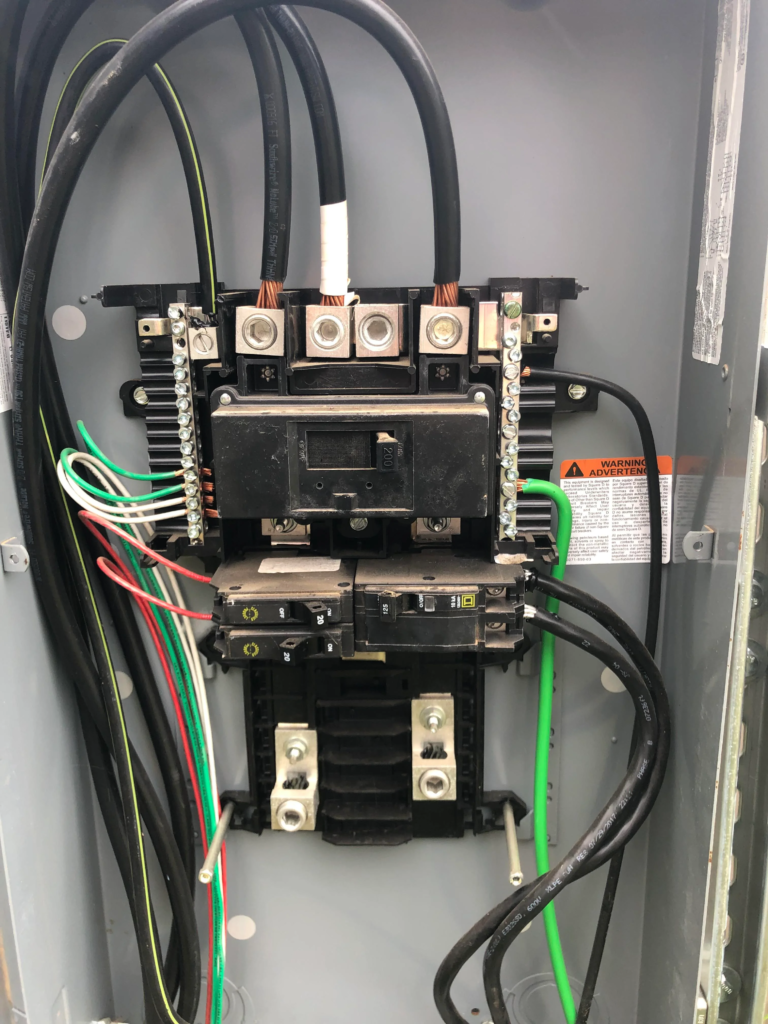
In this article, we will explore the question “What size aluminium wire for 125 amp service?
For a 125 amp service, the recommended wire size is 1/0 AWG for copper or 2/0 AWG for aluminum. The specific wire size requirements may vary based on factors such as the type of installation and the distance between the service panel and the main electrical utility connection.
It is essential to select the appropriate wire type based on electrical code requirements and environmental factors. Consulting a qualified electrician is recommended to ensure compliance with local electrical codes and regulations.
The wire size is determined based on factors such as ampacity, voltage drop, and environmental conditions. The ampacity of the wire must be capable of safely carrying the maximum expected current without exceeding its limit.
Voltage drop, which is the decrease in voltage along the length of the wire, should also be considered to ensure the proper functioning of the electrical system.
In summary, for a 125 amp service, the recommended wire size for aluminum is 2/0 AWG, taking into account the specific requirements of the installation, and consulting a qualified electrician to ensure compliance with local electrical codes and regulations is highly advisable.
- What size aluminium wire for 125 amp service? The Factors to Consider
- How does voltage drop affect wire size selection for a 125 amp service?
- What is the maximum distance that can be covered by a 2/0 AWG aluminum wire for a 125 amp service?
- What is the difference between a feeder wire and a service entrance feed for a 125 amp service?
- Can smaller diameter copper wire be used compared to aluminum wire for the same amp load?
- What are the disadvantages of using copper wire over aluminum wire for the same amp load?
- Helpful Resources
What size aluminium wire for 125 amp service? The Factors to Consider
When selecting the appropriate wire size for a 125 amp service, several factors should be considered, including:
1. Ampacity: The wire size must be capable of safely carrying the maximum expected current without exceeding its limit.
2. Type of Installation: The wire size requirements can vary depending on factors such as the type of installation (e.g., commercial, residential) and the distance between the service panel and the main electrical utility connection.
3. Environmental Factors: If the wire is exposed to harsh conditions, such as extreme heat or moisture, it may require additional protection or specific wire types.
4. Electrical Code and Regulations: It is essential to consider the electrical code and regulations applicable to the specific location to ensure compliance with the required standards.
5. Voltage Drop: Voltage drop, which is the decrease in voltage along the length of the wire, should be considered to ensure the proper functioning of the electrical system.
6. Specific Electrical Load and Temperature Rating: The required electrical load, temperature ratings, and the distance of the wire run are crucial factors in determining the appropriate wire size.
Consulting a qualified electrician is advisable to ensure that all these factors are carefully evaluated and to guarantee compliance with local electrical codes and regulations.
How does voltage drop affect wire size selection for a 125 amp service?
Voltage drop affects wire size selection for a 125 amp service by ensuring that the proper amount of voltage reaches the electrical equipment at the end of the wire.
As electricity flows through a wire, there is a decrease in voltage, known as voltage drop, which should be kept within acceptable limits to ensure the proper functioning of electrical equipment.
The distance between the service panel and the utility connection is a factor in determining the acceptable voltage drop, and wire size is selected accordingly.
Here are some key points about voltage drop and wire size selection:
1. Voltage Drop: Voltage drop refers to the decrease in voltage that occurs as electricity flows through a wire. It is essential to minimize voltage drop to ensure the proper functioning of electrical equipment.
2. Wire Size: Wire size is selected to compensate for voltage drop, ensuring that the maximum voltage reaches the electrical equipment at the end of the wire. Larger wire sizes can handle longer distances and lower voltage drops.
3. Distance: The distance between the service panel and the utility connection affects the acceptable voltage drop. The longer the distance, the larger the wire size required to minimize voltage drop.
4. Voltage Drop Calculation: Voltage drop can be calculated using various formulas, such as the Ohm’s Law formula or the voltage drop calculator provided by the National Electrical Code (NEC).
5. Acceptable Voltage Drop: The acceptable voltage drop depends on the specific electrical equipment and its power requirements. Typically, a voltage drop of 3% to 5% is considered acceptable for most electrical equipment.
In summary, voltage drop is an essential factor to consider when selecting the appropriate wire size for a 125 amp service, as it ensures that the maximum voltage reaches the electrical equipment at the end of the wire, providing safe and efficient operation.
What is the maximum distance that can be covered by a 2/0 AWG aluminum wire for a 125 amp service?
The maximum distance that can be covered by a 2/0 AWG aluminum wire for a 125 amp service depends on the acceptable voltage drop and the specific installation requirements.
According to the information available, for a 125 amp service, a 2/0 AWG aluminum wire is suitable for distances up to 200 feet, considering a 3% allowable voltage drop.
However, it’s important to note that the maximum distance may vary based on the acceptable voltage drop and other factors specific to the installation.
Consulting a qualified electrician and referring to the National Electrical Code (NEC) for the most accurate and up-to-date information is recommended to determine the maximum distance for a 2/0 AWG aluminum wire in a particular electrical installation.
What is the difference between a feeder wire and a service entrance feed for a 125 amp service?
A feeder wire and a service entrance feed are two different components of an electrical system, and their functions and requirements differs.
Feeder Wire:
1. A feeder wire is a high-voltage wire that transfers electrical power from the utility power source to the service panel in a building.
2. Feeder wires are typically installed within the walls of a building and are not accessible to the homeowner.
3. They are sized according to the electrical code and the distance between the utility power source and the service panel.
4. Feeder wires can be made of either copper or aluminum, but copper is more common.
Service Entrance Feed:
1. A service entrance feed, also known as a service drop, is the portion of the feeder wire that extends from the utility pole to the service panel in a building.
2. Service entrance feeds are installed on the exterior of the building and are accessible to the homeowner.
3. They are subject to weather conditions and physical damage, so they are typically made of aluminum for better durability.
4. Service entrance feeds are sized according to the electrical code, the distance between the utility pole and the service panel, and the total number of circuits in the building.
In summary, a feeder wire is responsible for transferring electrical power from the utility source to the service panel, while a service entrance feed is the portion of the feeder wire that extends from the utility pole to the service panel.
The choice of material (copper or aluminum) depends on various factors, including the specific application and local electrical code requirements.
Can smaller diameter copper wire be used compared to aluminum wire for the same amp load?
Yes, smaller diameter copper wire can be used compared to aluminum wire for the same amp load. This is due to the difference in the electrical properties of copper and aluminum.
Copper has a higher conductivity than aluminum, which means it can carry the same amount of current with a smaller cross-sectional area compared to aluminum.
As a rule of thumb, when replacing copper conductors with aluminum, the aluminum conductors should be two American Wire Gauge (AWG) sizes larger than the copper conductors to achieve the same ampacity.
Therefore, for the same amp load, copper wire can be smaller in diameter than aluminum wire.
What are the disadvantages of using copper wire over aluminum wire for the same amp load?
The disadvantages of using copper wire over aluminum wire for the same amp load include the following:
1. Cost: Copper wire is more expensive than aluminum wire, which can significantly impact the overall cost of an electrical project, especially for extensive wiring.
2. Weight and Size: Copper wire is heavier and takes up more space than aluminum wire for the same ampacity, which can lead to increased material and installation costs, particularly in large-scale projects.
3. Conductivity and Resistance: While copper has higher conductivity and lower resistance than aluminum, the difference is not significant for most residential and commercial applications. However, in industrial settings or for long runs, the higher resistance of aluminum may lead to more significant voltage drop, requiring larger wire sizes to compensate.
4. Flexibility and Termination: Copper wire is more flexible and easier to work with than aluminum, which can lead to lower labor costs during installation. Additionally, aluminum wire requires special compounds at termination points to avoid potential hazards, which can increase installation complexity and cost.
5. Thermal Expansion and Strength: Copper has a lower thermal expansion and higher tensile strength compared to aluminum, making it less prone to breakage during installation and less susceptible to damage from temperature changes.
6. Corrosion and Fire Risk: Aluminum wire is more susceptible to corrosion, which can increase its fire risk if not properly installed and maintained.
In summary, while copper wire offers advantages such as better conductivity and lower resistance, it is important to consider the higher cost, weight, and size, as well as the differences in flexibility, termination requirements, and susceptibility to corrosion and fire risk when compared to aluminum wire.
Helpful Resources
- https://homealliance.com/faq/what-size-wire-do-i-need-for-125-amp-service
- https://www.angi.com/articles/125-amp-wire-size.htm
- https://www.galvinpower.org/what-size-wire-for-125-amp-breaker/
- https://original.newsbreak.com/@eric-stone-1727464/3118493917527-125-amp-wire-size-and-breaker-guide
- https://learnmetrics.com/125-amp-wire-size/
- https://homeinspectioninsider.com/125-amp-wire-size/
- https://www.garagejournal.com/forum/threads/125-amp-service-what-wire-size-to-use.49607/
- https://www.gordian.com/resources/copper-versus-aluminum-wire/
- https://paramountcables.com/blog-posts/copperwire-aluminum-wire/
- https://paramountcables.com/blog-posts/copperwire-aluminum-wire
- https://thecorrecter.com/how-to-remove-scratches-from-aluminium-4/
- https://thecorrecter.com/how-is-aluminium-mined-2/
- https://thecorrecter.com/is-aluminium-malleable-and-ductile/
- https://thecorrecter.com/does-aluminium-cause-dementia-2/
- https://thecorrecter.com/how-to-restore-aluminium-boat/
- https://thecorrecter.com/how-to-remove-anodising-from-aluminium-2/
- https://thecorrecter.com/can-aluminium-be-soldered/
- https://thecorrecter.com/how-does-aluminium-cans-affect-the-environment/
- https://thecorrecter.com/does-aluminium-foil-catch-fire/
- https://thecorrecter.com/can-you-weld-aluminium-with-flux-core/
- https://thecorrecter.com/how-to-clean-aluminium-siding/
- https://thecorrecter.com/can-aluminium-foil-be-recycled/
- https://thecorrecter.com/does-aluminium-foil-conduct-electricity/
- https://thecorrecter.com/is-aluminium-conductive-to-lightning/
- https://thecorrecter.com/can-you-weld-aluminium-with-a-stick-welder/
- https://thecorrecter.com/is-aluminium-metal-or-non-metal/
- https://thecorrecter.com/how-to-weld-aluminium-with-a-mig-welder/
- https://thecorrecter.com/how-to-solder-aluminium-with-a-soldering-iron-3-best-steps/
- https://thecorrecter.com/is-forged-aluminium-cookware-safe/
- https://thecorrecter.com/is-aluminium-in-deodorant-harmful/
